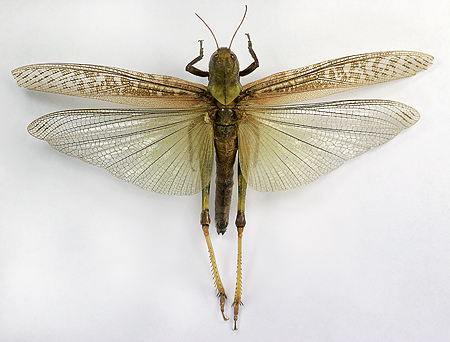Pests
Locusta migratoria L. - Migratory Locust, Asiatic Locust.
Systematic position.
The class Insecta, order Orthoptera, family Acrididae, subfamily Acridinae, tribe Locustini, genus Locusta. Within the limits of former USSR two subspecies, including nominotypic one. L. migratoria rossica Uv. et Zol. is widespread in forest-steppes and in the south of forest zone of European Russia.Synonmyms.
Locusta dancia L.; Pachytylus migratorius; P. danicus; Acridium migratorium.Biological group.
Polyphagous insect pests.Morphology and biology.
A large insect, with body length, 35-50 (male), 45-55 mm (female). Frons vertical. Mandibles blue. Pronotum without cruciform figure. Elytra lengthy, shining, 43.5-56.0 (males), 49.0-61.0 mm (females) in length. Wings colorless, without bands. Hind femora bluish-black from below in basal part. Length of hind femur 22.0-26.0 mm in males, 20.0-32.0 mm in females. Hind tibia yellowish or red. Thorax covered with dense pile of short hairs from below. The coloring can vary, it is usually green, brown, yellowish-green, or gray. Pronotum saddle-shaped in individuals of gregarious phase, with distinct strangulation and with straight or slightly concave median keel (in lateral view). In individuals of solitary phase the pronotum does not have strangulation, with high arcuate (lateral view) median keel. Egg pod large, slightly bent, sometimes straight, laterally weakly squeezed, 50-85 mm in length, 7-10 mm in diameter. It forms a column of foamy pinkish-white secretion containing 40 to 120 eggs. Walls soft, mat, brown-pink, powdered with soil particles. Egg thin, narrowing to both apices, yellow, gently shining, 7-8 mm in length, arranged in 4 longitudinal rows at 40-45° angle to lateral walls. The secretion does not fasten eggs, mounting upward in shape of thin columns 1/4-1/5 the length of egg pod. Upper end of the egg pod is located at a depth of 5-8 mm below soil surface. Light sandy soils are favorable for egg laying. Larvae have 5 instars.Distribution.
The area of the Migratory Locust embraces practically all temperate and tropical regions of the eastern Hemisphere. Its northern boundary in Eurasia coincides approximately with the southern border of the taiga zone. In the former USSR - central band and south of the European part, the Caucasus, the south of Siberia and Primorskii Territory, Kazakhstan, Central Asia, Kurile islands (Kunashir).Ecology.
Reproduction niduses on beaches of rivers, lakes, and seas, in reedbeds (Phragmites australis) generating large thickets. The Migratory Locust has 7 regions of constant habitat in the former USSR including the most active localities at Balkhash-Alakol lakes and Amu Darya river and (recently) in Northern Caspian and Dagestan regions. Hatching in the majority of localities is observed in the middle or at the end of May. Hatching is quick, finishes for 4-5 days in every station. The larval development lasts 35-40 days (i.e., 7-8 days for each instar). The larvae of a gregarious phase gather flocks from the first days after hatching. Maximum insect density in flocks reaches 80,000 indidviduals/m2 for 1st instar larvae and 7,000 individuals/m2 for 5th instar larvae. Flocks of larvae can migrate on big distance. At poor vegetation 5th instar larvae pass over 3 km per day. Adult individuals appear at the end of June or at the beginning of July. Mass flights of the flocks start in approximately 10 days after winging. The copulation starts in 2-4 weeks after winging, and in 2-3 weeks more (usually at the end of July) females start to lay eggs. Each female makes 2-3 (to 5 in southern localities and at warm weather) egg pods containing 60-80 eggs on the average (120 ones maximum). The Migratory Locust is rather narrow oligophage preferring wild cereal grasses (e.g., reed, couch-grass). But it can feed on plants of many families after leaving their reproduction niduses or at lack of favorite cereal forage. Each individual eats from 300 to 500 g of green forage during its life. Population dynamics is intimately connected to changes of water balance in reproduction localities; the alternation of seasonal floods and dryings in reedbeds causes reduction or spreading of food supply and sites for reproduction.Economic significance.
The larvae and adults of a gregarious phase strongly harm wheat, rye, barley, oat, corn, rice, panicum, sorghum, alfalfa, peas, legumes, string bean, soya, clover, and other fabaceous crops, red and sugar-beet, potato, tobacco, poppy, cabbage, rutabaga, cucumbers, watermelons, melon, and other gourds, sunflower, hemp, hop, buckwheat, althaea, cotton, flax, Palma Christi, vegetable and other crops, young plants of many fruit, forest, and bushy species, hay lands, pastures. In limits of the former USSR the Migratory Locust remains habitats and niduses of originating gregarious phase, whence it still commits periodic flights, in Lower Volga Basin and Caspian regions, in region of the Aral sea (lower river basins of Irgiz, Turgai, Chu, Syr Darya and Amu Darya) and in basins of lakes Balkhash, Alakol, and Zaisan. Individuals of a solitary phase damage a little various vegetable crops, rice, cotton, and plantations of volatile-oil-bearing plants in Tadjikistan.Reference citations:
Bei-Bienko G.Ya. 1932. A manual of locust survey. Leningrad: Upravlenie Sluzhby ucheta Gos. OBV Narkozema SSSR. 159 pp.Bei-Bienko G.Ya., Mishchenko L.L. 1951. Locusts of the fauna of the USSR and adjacent countries. Keys to Fauna of USSR, N38, parts I & II. Moscow & Leningrad: AN SSSR. 668 pp.
Lachininskii A.V., Sergeev M.G., Chil'debaev M.K., Chernyakhovsky M.E., Lockwood J.A., Kambulin V.E., Gapparov F.A. 2002. Locusts of Kazakhstan, Central Asia and adjacent territories. Larami: Association for Applied Akridology International, University of Wyoming. 387 pp.
Mishchenko L.L. 1952. Locusts (Catantopinae). Fauna of the USSR. Orthopterous insects. Leningrad: AN SSSR. V. 4(2): 610.
Sergeev M.G. 1986. Regularities in distribution of orthopterous insects of Northern Asia. Novosibirsk: Nauka. 238 pp.
Tsyplenkov E.P. 1970. Locust pests in the USSR. Leningrad: Kolos. 272 pp.


